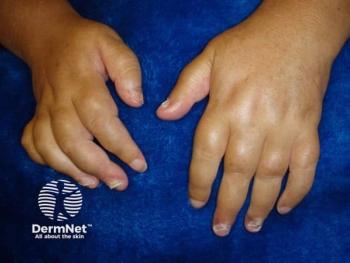
Study: Lifestyle Behaviors Linked With Psoriasis Development
Lifestyle behaviors, such as body mass index and smoking, were shown to have a stronger association with psoriasis, regardless of genetic risk.
In determining risk of
Characterized as an immune-related inflammatory skin disorder, psoriasis has been shown in prior research to be associated with certain genetic susceptibility. Genetic variants have been implicated in the pathogenesis of psoriasis, noted researchers, as well as several modifiable risk factors, including a high body mass index (BMI), smoking, physical activity, and dietary habits.
“Psoriasis can be triggered by both behavioral and genetic factors. Nonetheless, health behaviors and genetic risk factors have often been investigated separately,” they said. “Whether lifestyle is associated with the risk of psoriasis in the presence of different genetic risk levels remains unknown.”
Researchers conducted a prospective cohort study of data derived from the UK Biobank to investigate the gene-behavior interaction in association with incident psoriasis. Data from a total of 345,672 patients (mean [SD] age, 56.53 [8.06] years; 52% female) were included in the analysis.
Genetic risk was categorized into low, intermediate, and high groups, and lifestyle score comprising BMI, smoking, physical activity, and diet, were differentiated as ideal, intermediate, and poor. The study cohort included 2258 patients with incident psoriasis and 343,414 patients with no psoriasis.
“Within each genetic risk group, the risks of incident psoriasis associated with each lifestyle level were investigated and compared with the low genetic risk and ideal lifestyle group,” explained the study authors.
Overall, findings indicated that risk of incident psoriasis significantly increased in the poor vs ideal lifestyle groups (HR, 2.604; 95% CI, 2.042-3.319), and the high vs low genetic risk groups (HR, 1.342; 95% CI, 1.180-1.526).
The joint effect of genetic risk and lifestyle further showed that compared with the low genetic risk and ideal lifestyle group, the poor lifestyle and high genetic risk group was associated with a more than 4-fold increased risk of psoriasis (HR, 4.625; 95% CI, 2.920-7.348). No interaction between genetic risk and lifestyle was observed.
In response to the absence of interactions between genetic risk and lifestyle, researchers performed a population-attributable fraction (PAF) of both variables. In their findings, 32.2% (95% CI, 25.1%-38.6%) of new-onset psoriasis events during follow-up might have been prevented if all individuals would have adhered to ideal lifestyle, according to the PAF, whereas only 13.0% (95% CI, 3.2%-21.8%) of new-onset events would be reduced if all individuals were low genetic risk.
“To our knowledge, this study was the first to report the associations of combined health lifestyle and genetic risk for psoriasis,” concluded the study authors. “The results suggest the importance of a joint assessment of the risk of psoriasis for individuals—the establishment of an integrated ideal lifestyle for the prevention of psoriasis should be advocated.”
Reference
Shen M, Xiao Y, Jing D, et al. Associations of combined lifestyle and genetic risks with incident psoriasis: a prospective cohort study among UK Biobank participants of European ancestry. J Am Acad Dermatol. 2022 Apr 12;S0190-9622(22)00604-1. doi:10.1016/j.jaad.2022.04.006
Newsletter
Like what you’re reading? Subscribe to Dermatology Times for weekly updates on therapies, innovations, and real-world practice tips.


















